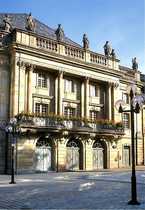Margravial Opera House
Joseph Saint-Pierre
Markgräfliches Opernhaus | |
| mutasd a térképen | http://www.schloesser.bayern.de/deutsch/schloss/objekte/bay_oper.htm |
fontosabb események
személyek
történet
Wilhelmine, the favourite sister of the Prussian king Frederick the Great, turned her residence, the city of Bayreuth, into a centre of the arts. Part of this strategy was a spectacular opera house, built 1746–1750. It became the most breath-taking theatre building north of the Alps. The facade follows French Classicism, inside it unfolds the splendour of Italian Baroque, designed by Giuseppe Galli Bibiena, the most important theatre architect of his time. It is a pleasure “reading” the decoration of the auditorium: up to the royal box one can discover how the presence of the Margrave couple was as important as the performance.
Also in and around Bayreuth: the theatre of ruins in the Hermitage (1744), the grotto theatre at Sanspareil (1747), Richard Wagner’s festival theatre (1876), and much more.
Markgräfliches Opernhaus ⋅ Opernstrasse 14 ⋅ 95444 Bayreuth ⋅ Tel.: +49 (0)921 7 59 69 22 ⋅ E-mail: sgvbayreuth(at)bsv(dot)bayern(dot)de ⋅ www.schloesser.bayern.de
Visits: 9:00 to 18:00 (April–Sep); 10:00 to 16:00 (Oct–March)
szabályozatlan
nincs
Add information





































